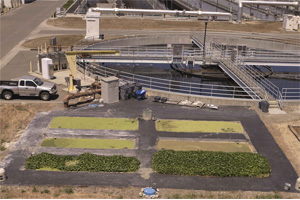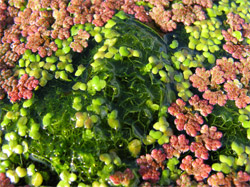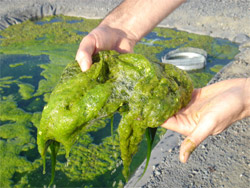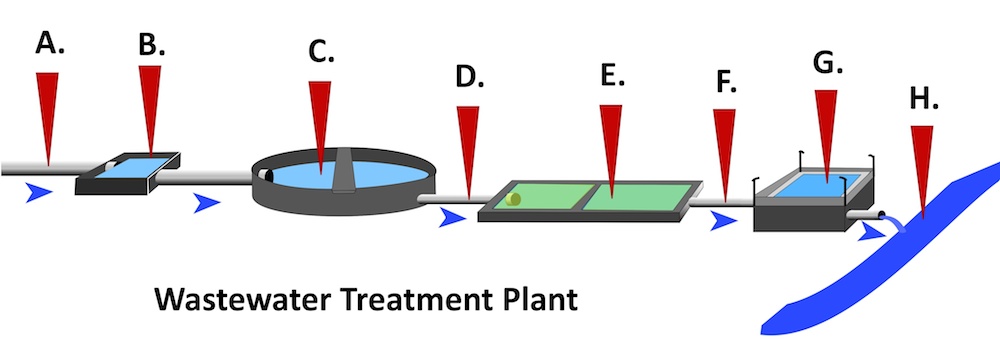
Chapter 16. Using Algae to Treat Toxins
Using Algae to Treat Toxins


Contaminants down your drain
Without even knowing it, many people flush toxic products down their drains. Along with the soapy water, wastewater treatment plants receive cleaning chemicals, cosmetic ingredients, and even estrogens from the birth control pills women take (which pass through into their urine). The toxic residue of pharmaceutical products ends up at treatment plants as well when clueless people put pills down their drains.
This is why researchers are studying algae. Professor Mike Cohen of Sonoma State University has constructed trial ponds that use algae and other aquatic plants to purify the water of stubborn chemicals. Built at the City of Santa Rosa Laguna Wastewater Treatment Plant in California, the ponds take in water that has been through the normal treatment process, and scrub away many remaining pollutants.
Building an algae filter at a treatment plant
At the Santa Rosa Laguna Wastewater Treatment Plant, sewage water is stirred through murky pools. Aerating bubbles take ammonia, which comes from the urea in urine, and turn it into nitrate. Bacteria then turn nitrates into nitrogen gas. Pools like these do an effective job of getting out human waste, but flushed contaminants that are small, stubborn, or very concentrated can escape the purification process. As a result, after the treated water is released into rivers and streams, it may contain ingredients that harm fish and wildlife.

To make an algae filter, Cohen and his students collect samples of wild algae and aquatic plants from natural ponds. Cohen says that lush, wild filamentous algae (the kind that grow on the surface of the water) are better filters than planktonic algae (the kind that sometimes find their way into these pools on their own and cloud the water).
Cohen and his students grow the wild algae in shallow pools at the wastewater treatment facility. After the water has been through the treatment process, it’s pumped to the algae channel, where the green slime scrubs the water as it grows and multiplies.
How algae clean up toxins
Much like humans digest sugar, some algae use toxins as a source of carbon by breaking down the toxic chemicals. The presence of algae and plants can also stimulate photodegredation. This means the toxins are broken down by light energy, which is transferred from the algae molecules to toxins, such as pharmaceutical wastes. Filamentous algae additionally support the growth of bacteria, which consume nutrients from organic pollutants. There are more of these good bacteria in algae ponds than in typical water treatment pools.
Cohen and his students found that diverting water through constructed algae channels greatly reduces the amount of estrogen compounds, nitrates, and metals. Many of the toxins missed during the wastewater treatment process are removed. When the water is finally returned to the environment, it’s less harmful to fish and wildlife.
Treating eutrophication
This same technology can be used to purify rivers, lakes, and streams that suffer increased nutrient levels due to pollution—a condition called eutrophication. Nitrogen compounds from agricultural and lawn fertilizers seep into waterways when it rains. This runoff over-fertilizes ecosystems, resulting in rampant weed growth. Residual waste products from the agricultural industry have been linked to clogged wetlands and rivers, which fill up quickly with non-native trees and shrubs. When these pollutants reach large bodies of water, they cause toxic algal blooms that kill fish.
By diverting some of the water in a stream through a constructed canal of harmless algae, the nitrites are almost entirely removed. The algae use these nutrients as food, returning the water to the stream in a cleaner state.
Converting algae to fuel

Since the algae use the toxins for food, they are constantly growing and dividing. To keep water flowing through the ditches and ponds at the right rate, algae must be harvested. Fortunately, there are a few uses for the goop! Algae can be pressed to make biodiesel—an oily fuel that is burned in diesel cars in place of fossil fuel.
Algae can also be fermented in a digester to make methane—a clean-burning fuel that can be used to run an electricity generator. Cohen is doing this at the Laguna Water Treatment plant.
While algae filtration methods were first developed in the 1950s, most treatment plants opted to build standard facilities instead. Recent research has helped validate algae as a viable water scrubber. Now, waste treatment facilities in California, Texas, and other states are integrating algae beds and constructed wetlands to better purify water.
Although, not even the best algae pond can get rid of all pollutants. As very low doses of estrogenic and pharmaceutical compounds can have a big environmental impact, it’s best to keep these from going down the drain in the first place.
© 2015 WH Freeman and Company.
16.1 Comprehension Questions
Answer the following questions to demonstrate your understanding of the article.
1.
Treating wastewater to remove toxins produces large quantities of algae. Fortunately, there are a number of uses for algae, including pressing it to produce ______, which can be used to fuel automobiles.
| A. |
| B. |
| C. |
| D. |
| E. |
2.
Harvested algae also can be fermented in a digester to create , a clean-burning fuel.
3.
When treating wastewater, sewage is collected in pools, stirred, and then aerated, which takes ammonia from urea and turns it into nitrates. Bacteria then convert nitrates into ________.
| A. |
| B. |
| C. |
| D. |
| E. |
4.
Fill in the Blank:
Fertilizer run-off from lawns and farmland can cause a condition known as , which is defined as excessive nutrient levels in rivers, lakes, and streams as a result of pollution.
5.
Algae and plants can help stimulate photodegradation, where toxins are broken down by energy.
6.
Professor Mike Cohen and his students found that diverting wastewater through algae channels was beneficial. What was the benefit?
| A. |
| B. |
| C. |
| D. |
| E. |
7.
True or False:
Professor Cohen and his students found that the best type of algae for “scrubbing” wastewater of particulate matter is planktonic algae.
8.
You are cleaning out your medicine cabinet and find a number of expired prescription medications. What is the BEST way to dispose of them?
| A. |
| B. |
| C. |
| D. |
| E. |

Read the following paragraph and refer to the figure when answering the next 2 questions.
The figure above is a simplified diagram of a wastewater treatment plant. (You can click on the image and expand it for closer examination.) Wastewater, including sewage and other wastes from homes and businesses, enters the plant through pipe A, and then moves into the screening tank (B). Here, large objects are filtered out of the wastewater. Next, wastewater leaves the screening tank and enters the aerating tank (C). The aerating tank uses bubbles of air to take ammonia from urea and converts the ammonia to nitrate. The tank also contains bacteria that break down the nitrates into nitrogen gas. Once bacteria break down the organic materials, wastewater then moves through a pipe (D) to the algae tank (E), where toxins and other hazardous materials are broken down. Next, the wastewater moves through a pipe (F) to the purifying tank (G), where living organisms (i.e. bacteria) are killed by chlorine. From there, the sanitized water is then pumped into a body of water—in this case, a river (H).
9.
If you wanted to determine the plant’s effectiveness in removing toxins from wastewater (including those from pharmaceutical wastes), what are the best locations throughout the plant to gather samples for analysis?
| A. |
| B. |
| C. |
| D. |
| E. |

10.
The treatment plant’s automatic monitoring system reports there is a problem: air has stopped bubbling through the aerating tank (C). What would you expect to find if you analyzed a sample of wastewater from location “D”?
| A. |
| B. |
| C. |
| D. |
| E. |
Activity results are being submitted...